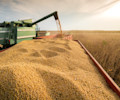Animal protein producers face a range of sustainability risks. By diversifying into sustainable proteins, these businesses can hedge these risks and enter a fast-growing market.
At the same time, innovation in food technology is accelerating and is creating protein production opportunities with the potential to disrupt the incumbent industry. For intensive animal protein producers, a failure to engage with this innovation is a risk. Diversification into producing alternative (i.e. non-animal) proteins is therefore key for both managing the risks of resource-constrained supply chains and for seizing opportunities for market growth.
Meat alternatives and broader protein alternatives that can act as substitutes for traditional animal‑based food are attracting considerable financial investment.
Here we explain what alternative protein is, and why investors are engaging in this new market.
What is alternative protein?
‘Alternative proteins’ is a general term that covers plant-based and food-technology alternatives to animal protein.
Plants
Consuming more whole plants and crop extracts (such as grains, legumes, nuts, pulses and seeds).
Algae
Producing and harvesting protein biomass from macro and micro-algae.
Insects
Introducing insect protein (such as crickets) into the westernised diet.
Fermented proteins
Creating animal proteins such as casein and whey. This is done through a brewing process whereby yeast organisms are programmed to produce the proteins in a more efficient way than from animal sources
Cultured or ‘clean’ meat
Growing meat products from cells sourced from animal muscle and tissue in a laboratory, without raising and processing animals
Our definition of sustainable protein
We define sustainable proteins as protein-rich food sources that are:
consistent with nutritional requirements
produced to high environmental and ethical standards
diversified in their sourcing.
The most sustainable form of proteins do not involve large-scale livestock or fish production, primarily because of the difficulties of producing animal protein sources that are carbon-neutral, high-welfare, environmentally responsible and efficient.
How will alternative protein change the face of the farming industry?
Alternative proteins have the potential to structurally shift the intensive livestock industry, as the sector may see itself expand from a ‘meat’ industry to a broader ‘protein’ industry. These products can be used to produce protein-rich foods without animals, for a fraction of the cost and with significantly reduced external impacts. Bypassing the inherent inefficiencies of livestock production, such as plant-to-animal feed conversion, means innovation in this space could fundamentally disrupt the market.
Alternative proteins, or meat alternatives, are terms used to describe either plant-based or food-technology (‘clean meat’) alternatives to animal protein. They are products that replicate animal agriculture products and provide consumers with products that have a similar look, texture and taste to animal-based meat products, but with a lower sustainability impact.
Protein trends
Growth in alternative proteins market
Animal protein producers face a range of sustainability risks. By diversifying into sustainable proteins, these businesses can hedge these risks and enter a fast-growing market. The US$1.4 billion meat alternatives industry in the US grew by 22% in 2017, with a Nielsen survey reporting that nearly 40% of Americans were trying to eat more plant-based foods.
Innovation in food technology is accelerating and creating protein production opportunities with the potential to disrupt the incumbent industry. For intensive animal protein producers, a failure to engage with this innovation is a risk. Diversification into producing alternative (i.e. non-animal) proteins is key for both managing the risks of resource-constrained supply chains and for seizing opportunities for market growth.
Meat taxes
Despite significant red flags from the medical profession and scientists as seen previously with regard to the tobacco industry, most governments have, so far at least, refrained from intervening in the market. However, FAIRR has warned investors that the implementation of the Paris Climate Agreement made the introduction of a tax on meat “increasingly probable”. In its report ‘The Livestock Levy’, FAIRR examined the increasing use of taxes by governments on products such as sugar, carbon and tobacco. More than 180 jurisdictions currently tax tobacco, with more than 60 putting a tax on carbon and at least 25 with taxes on sugar. FAIRR says meat is on the same path that led these goods to become the target of stand-alone taxes. The pathway is driven by a global consensus around meat’s negative contributions to climate change and global health epidemics such as obesity, cancer and antibiotic resistance.
Countries including Denmark and Sweden have already debated a meat tax, with proposals in Denmark suggesting a figure of approximately $2.7 per kilogram of meat. FAIRR has encouraged food companies to use an internal ‘shadow price’ of meat to account for future costs, in the same way many use internal carbon pricing.











